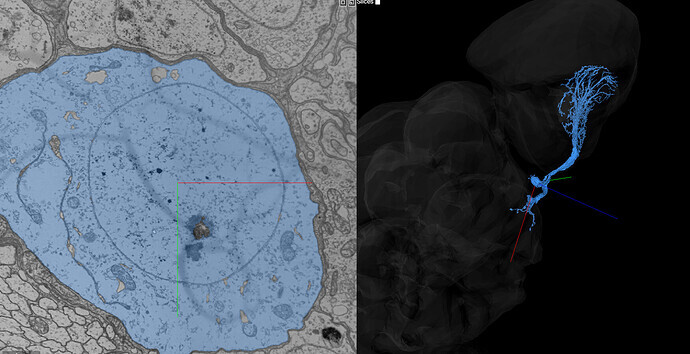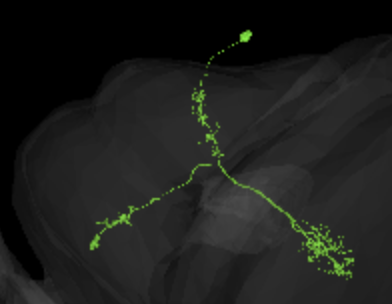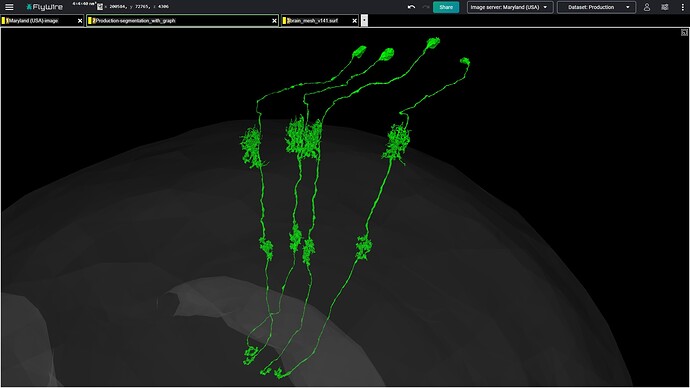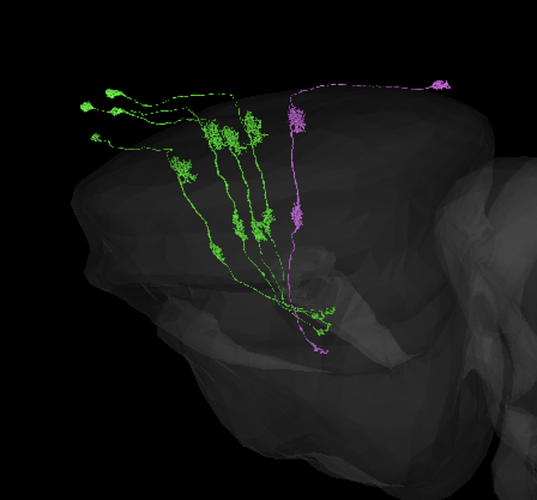TR77 i am thinking your cell is close to a Y(1) type but maybe a undiscovered variant with two arbours in the medula instead of 1
KK i do not think this is a Pm cell at all according to this picture https://cob.silverchair-cdn.com/cob/content_public/journal/dev/138/5/10.1242_dev.058370/3/dev058370f4.jpeg?Expires=1661433990&Signature=UPyjzNtck4o-5YdA56Y273wUCvKWVY5eO79XmdAqafQf0pAKyLHraaFKsVFJQQ8k~X5Uv9U4zZL1fBKins24aeYHNbzqOmwVWHRlLGpfLHOCgJr5WpKBHVlYjQZsbIeumBUBUdAnYuaMi3Cw8cPwTg3Zys8QjagXqhG~FVBWt8TNp1~k0CQXMOw7yju~0Bk58BB-hTdvJuHmLbkanctU8BiUmK1raAQFyCEmvXyvxhNTDXIIChqQp77Lxw1FxmCHxD219NuB5RpYGVEAENqaaJNpk1LBPo15uCsV4d75nTkYTp11wyiIjyWiTOZsSXXaaMJL0kuktJRRCFTIFmcarA__&Key-Pair-Id=APKAIE5G5CRDK6RD3PGA
the soma should go up against the medulla and not flat like that.
Also all the Pm cells i have seen is buquet types with the branches running paralell for a while before splitting of.
i am thinking this might be closer to a Mt cell, but not any of the ones pictured in fishback
Tm1??? (if anyone has a minute to check me on this)
Also, thanks @annkri for identifying the above as Y1. I’ll go back and check the medulla arbors…one of them still may be a merger. ![]()
https://ngl.flywire.ai/?json_url=https://globalv1.flywire-daf.com/nglstate/6106409494118400
Added in what is identified as a Tm1 in the guide in purple, but from what i can see that is actually a Tm1a (cb goes toward lobula/central brain) while yours is the Tm1 cells
https://ngl.flywire.ai/?json_url=https://globalv1.flywire-daf.com/nglstate/6016579623976960
I can’t seem to find the post where this cell was shared, but we do have ID for this one. Maybe it was from @Krzysztof_Kruk?
Emil Kind says “this is a a LPTC neuron (lobula plate tangential cell). Its a larger group of large-field motion-sensitive neurons. There are for example VS and HS LPTCs which are vertically sensitive (VS) or horizontally sensitive (HS). They all get input from T4 and T5.”

https://ngl.flywire.ai/?json_url=https://globalv1.flywire-daf.com/nglstate/4998700761874432
here it is:
I really wish, there was some sort of open source catalog of all types of neurons in a Drosophila brain. There’s, of course, Fischbach’s paper, but it’s only for optic lobula and even that’s missing some cells.
Hopefully, we’ll be able to do something like this in the spreadsheet in the future.
What about this Cell Identification search feature?
It is far from a spreadsheet that lists all the cells though. I could see if we could generate a list of the cell IDs. There are around 30K cells with information thus far.
It’s good, but still missing many many cell types.
It’s possible to download the whole database to a .csv file and open it in Excel or any other Spreadsheet tool, but again, not all cells’ types are there. I’d say, about half, if not more optic lobe cells’ types don’t exist there. And some of the existing entries seems to be incorrect.
Also, I might be wrong, but I think, some cells can have multiple names and some names can be added to multiple types of cells depending, where in the brain a cell is.
yes i think DM cells is a example on this, there looks too be some marked as DM in the central brain and ours marked Dm in the optic lobe
@Amy_R_Sterling do you know what type of LPT neuron that is, in the fishback paper it is listed Lpt 1 and Lpt 2, but from what i understand there might be more?

this is only marked as a y cell in the guide, i am thinking it might be a y6 any thoughs?
https://ngl.flywire.ai/?json_url=https://globalv1.flywire-daf.com/nglstate/5989709234831360
For the DM versus Dm cells, it can be a bit confusing due to how the “m” is capitalized.
DM = Drosophila melanogaster (fruit fly)
Dm = distal medulla
And I’m not sure what type of LPT neuron it is (I’ll see if I can find any papers with more details). The Fischbach paper only has the “fragments of LPT 1 & 2” in it and the writers concede that their “list of tangential neurons in the lobula plate of Drosophila has to be extended” so there are more types out there…
I think, it looks more like a Y3, because of how deep it penetrates the lobula. Y6 would be my second guess.
yes, it goes a bit deep, the reason i tought it was Y6 was because that extra twig before the main cluster in lobula on the Y3 cell
@annkri I come up with the same as @Krzysztof_Kruk …it looks like a toss up between Y3 and Y6.
Also, I don’t see any reference to Y2 in Fischbach…is there a Y2? If so, I’m curious what it looks like.
yes, I see the branch and wonder, if it’s a defining feature for Y3 or just something, that might happen to particular examples of them, but not to all of them.
I found these descriptions for both kinds:
Y3:
Wide-field Y neuron with a mix of bleb-type and fine arborizations in the lobula plate. These show some stratification, but cover all layers to some extent. The medulla branch has a relatively wide, terminal arborization field in M8-10 with a mix of bleb-type and fine arborization. The lobula innervating branch has narrow arborizations, also of mixed type in layers 2-5 (Morante and Desplan, 2008; Fischbach and Dittrich, 1989)
Y6:
Y neuron that arborizes relatively broadly in all lobula plate layers and with a mix of terminal morphologies. Its branch in the lobula has narrow and mainly bleb-type arborizations in layers 1-4. Its branch in the lamina has a broader, bushy, fine, terminal arborization domain in layers M8-9.
Still, hard to say.
@TR77 Yeah, indeed Fischbach doesn’t have an Y2.
@Krzysztof_Kruk Oh good, then we can just define anything we’re not sure about as “Y2”, lol. ![]()
On a more serious note…
Now that HQ has given us the go ahead to start identifying cells in the database, should we take a moment to agree on a naming convention, for identifying cells, so that our entries are consistent in the database? Any thoughts?
Out from that description it sounds very close, but also like two different people has written it so very difficult to make a decision based on these descriptions, in particular when only knowing half the yargon.
Oh, didn’t read the post yet, thanks.
As for having a consistent naming convention, I totally agree. For now, I’ve only named a couple of Mi cells, and wrote “Mi1” or something like this, and one Am/Lai, where I’ve given a source.
Agree. It would be cool, if we could somehow recognize, where the internal layers in 2D and 3D are in all 4 components of the optic lobe.
i have noticed that in most of the neurons in the optic lobe they write things like TmY15, TmY15_R is this showing if it is in the right or left lobe (what is the front if that is the case)

